COVID-19 impact on nursery performance and feed costs
Nursery mortality percentage spiked in May 2020 and remained higher throughout the rest of the year.
May 5, 2021
When the March 2020 outbreak of COVID-19 occurred, life, as we knew it, was destined to change and impact everyone’s way of life. The extent of the impact on the swine industry would not be felt until April 2020 when the first packing plants started to shut down due to employee health safety concerns. Unfortunately, pork producers are used to disruptions in their production pipeline, with swine health breaks being one of the main causes. These issues are usually isolated to individual companies rather than an entire industry, an industry that sends over 300,000 pigs to be harvested daily.
Pork producers immediately started asking themselves questions like: How long would the plant shutdowns last? How do I manage the pigs that are supposed to go to market or were supposed to be sent from a sow farm to their next destination? What will be the financial impacts on my company?
Each pork producer had to start making some very difficult decisions that would affect every aspect of their business. Understanding the pipeline of pork production meant hard decisions needed to start at the sow farm and trickle down through grow-finish. Diets were adjusted to slow growth, pig stocking densities were adjusted to accommodate those late growing pigs and pigs were shipped further than normal as producers needed to find alternative markets for their pigs. Producers remained hopeful that additional market loads would become available, but, for the most part, that availability came a lot later than anyone had hoped.
For this conversation, we are going to focus on how COVID-19 impacted the nursery portion of swine production, mainly focusing on mortality, performance, and costs. The nursery stage of a pig’s life usually lasts around 45 days when the pig leaves the sow farm at around 21 days of age and weighs roughly 12 pounds. While in the nursery stage, that pig will have a very specialized feed diet to accommodate the nutritional and health needs, as well as a proper living environment to ensure the pig is comfortable every second of the day. Lastly, but most importantly, that pig will have a human caregiver that will be there to ensure proper pig husbandry.
Nursery analysis was performed utilizing the MetaFarms Ag Platform with specific focus on the United States (U.S.) customers only. In the calendar year 2020, the U.S. MetaFarms customers had slightly more than 9,000 closeouts (9,085) with total pigs started of nearly 17,000,000. Chart 1 shows the nursery mortality percentage comparison between 2020 and 2019 by calendar month. Note how the first four months of the year are very similar between the two years, but that starting in May, the month following the first packing plant closures, the 2020 mortality percentage spiked and remained higher throughout the rest of the year.
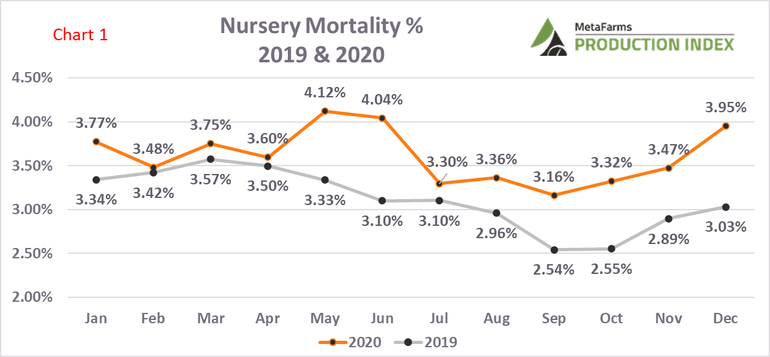
Diving deeper into how much COVID-19 impacted nursery mortality percentage, further analysis was done to look at the PEDV years of 2013 and 2014. Charts 2 & 3 show a four-year comparison of nursery mortality percentage. The first quarter of 2013 and 2014 was noticeably higher than other years until May 2020, when percentages began superseding every other year for the remainder of the year. Even with the two high mortality months at or near 5% in 2013, 2020 still had the highest yearly average at 3.61%, followed by 2013 at 3.57%.
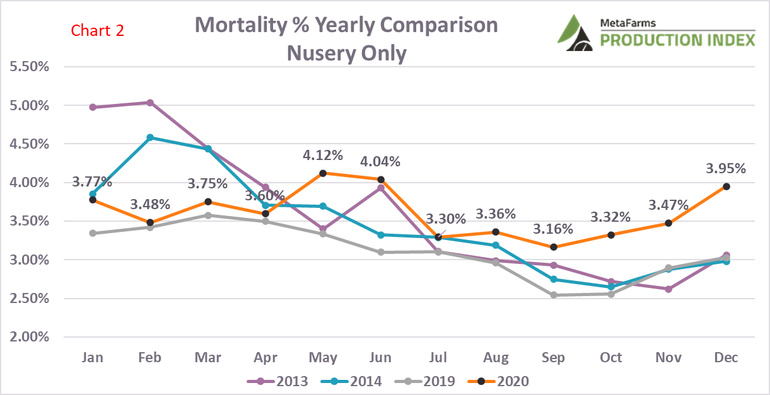
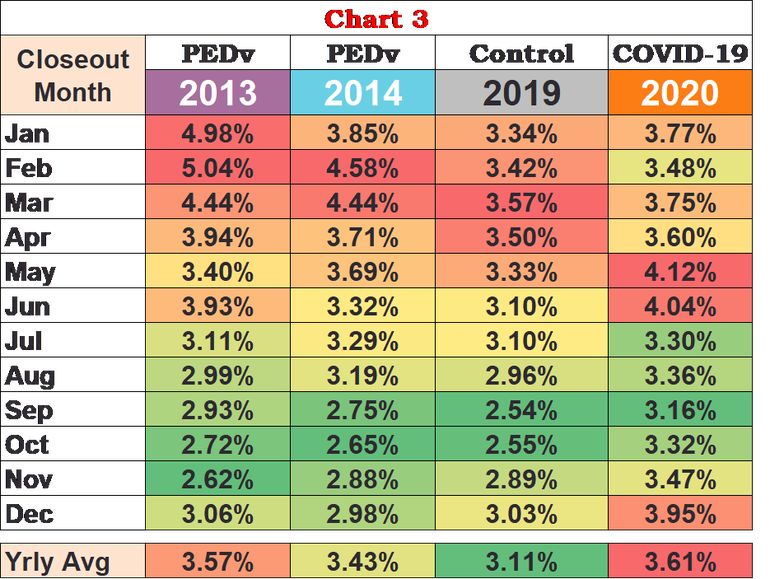
Nursery mortality was not the only metric impacted by pork packing plant closures, so an analysis was done by breaking apart 2020 into three timeframe segments. Chart 4 shows the performance and financial differences among the three timeframes. The first segment, called Pre-COVID, covers January-April; the second, called COVID, covers May-August; and the last, Post-COVID, covers September-December. We have already spoken on the mortality topic so we’re focusing on some other key metric differences between the COVID period and the others. The decision to keep pigs in barns longer showed the average days on feed (Avg DOF) was nearly two days longer and resulted in an average out weight per pig of 53.39 lbs. Correlating with pigs on feed longer, 2.3 more pounds of feed were fed per pig (lbs. feed per head).
With corn, soybean meal (SBM) and dried distiller’s grain with solubles (DDGS) making up most of a nursery diet, Chart 4 shows how producers added during the COVID period more corn and SBM to the diets but decreased the DDGS levels. During the COVID period, the average corn cost per bushel dropped by $0.52/bushel (13.7% change) while the less used but highly efficient soybean meal cost per ton only slightly increased by $4.36 per ton (1.5% change). The Post-COVID period saw a diet makeup of corn, SBM and DDGS similar to the Pre-COVID timeframe. However ,there was a noticeable jump in SBM cost per ton of $31.29 (10.6% change).
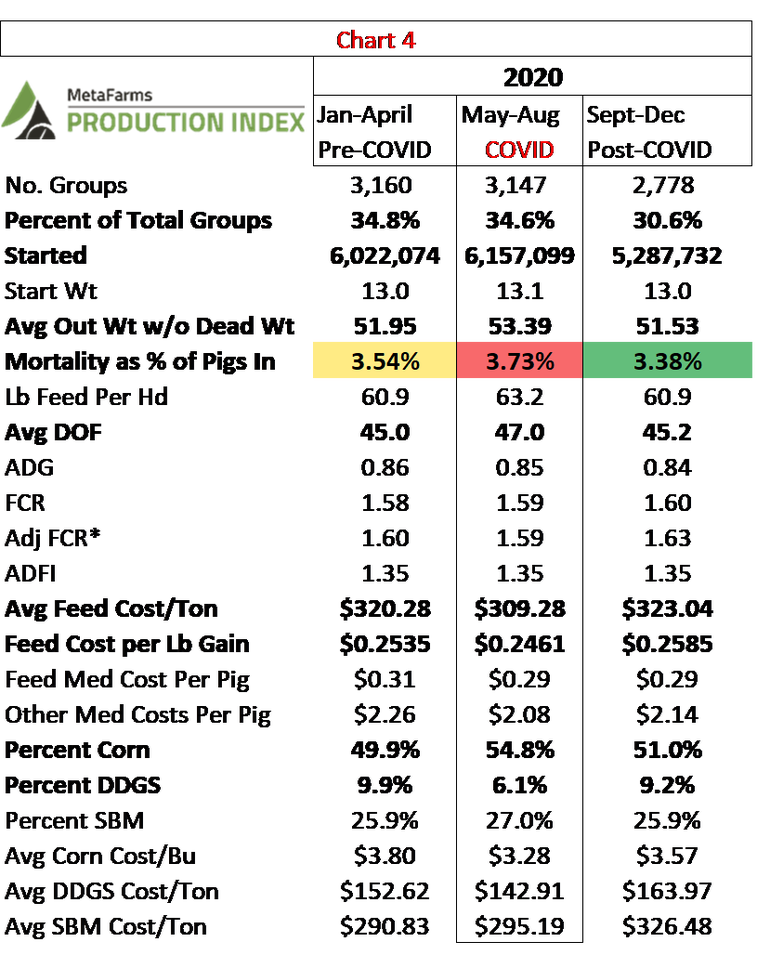
Chart 5, which covers the COVID period of May-August for the years 2013, 2014, 2019, and 2020, shows very key metric changes across those years. As many of us know, summertime weather means that pig growth slows down and generally pig health improves. 2020 shows the best-adjusted feed conversion (Adj. FCR) and average daily gain (ADG) among the four years. On another positive note, feed costs declined nicely in 2020 when compared to 2013/2014. In 2020, feed cost per pound of gain dropped by $0.1121, or a 31.3% change. Similarly, the average feed cost per ton was $144.79, or a 31.9% change.
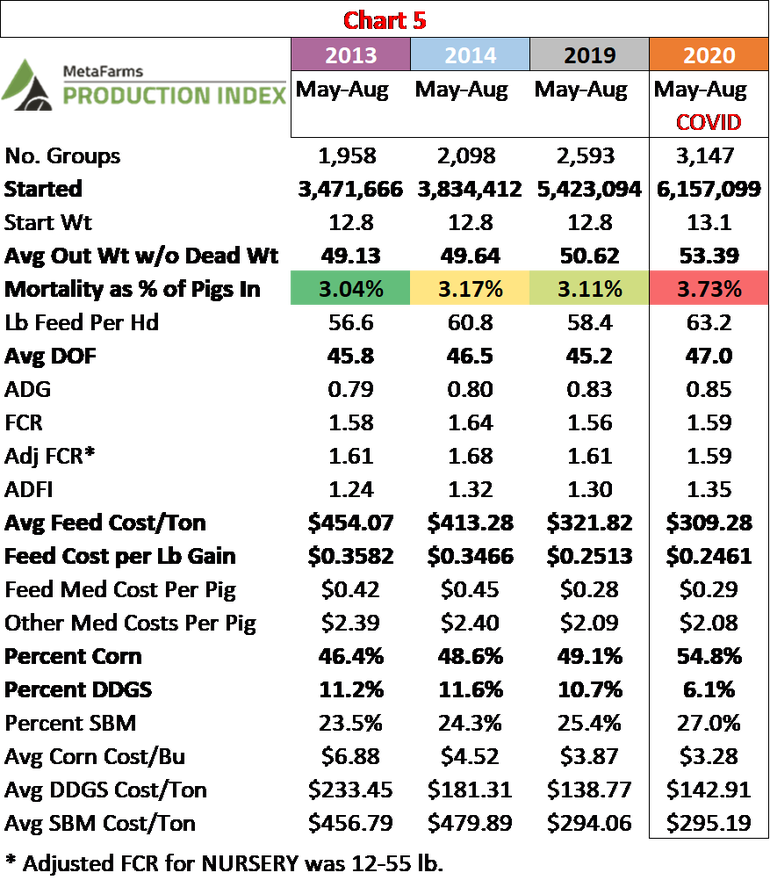
The saying “when life hands you lemons make lemonade” is appropriate for how pork producers handled the multitude of challenges in 2020. Long hours and tough decisions had to be made. Talking with producers last year, I heard the passion for doing what was right for the pigs while also taking care of their employees. There were several times last year that I saw social media posts about free pig giveaways for food shelves or for individuals who were hit even harder by COVID-19. It made me proud to work in an industry with such caring, hard-working people.
MetaFarms Analytic Insights were used to provide the context and trends for this article. If you would like to see an analysis of how COVID-19 impacted your marketing & finish mortality, or if you have suggestions on production areas to write articles about, please contact Bradley Eckberg or Ron Ketchem.
Sources: Bradley Eckberg, MetaFarms, who are solely responsible for the information provided, and wholly own the information. Informa Business Media and all its subsidiaries are not responsible for any of the content contained in this information asset.
You May Also Like



